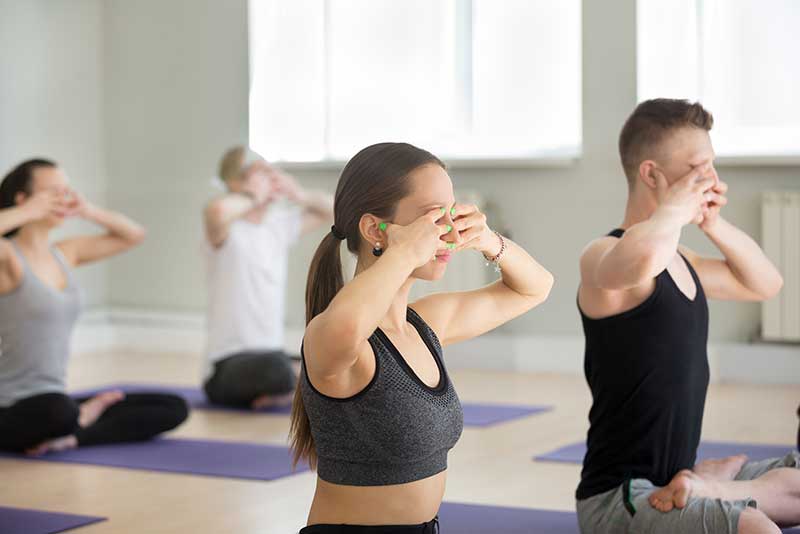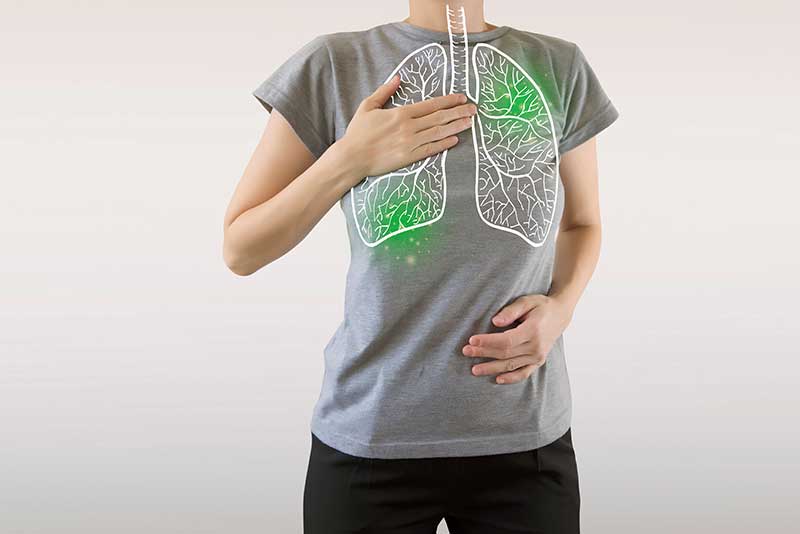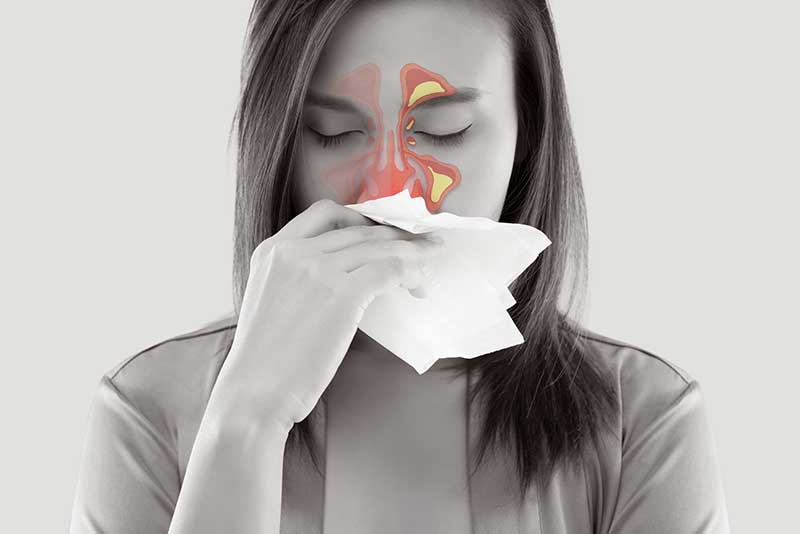Breath is a vital function of our body. In the discipline of yoga, the practice of conscious breath is known as pranayama. The pranayama or yoga breathing constitutes the fourth extremity in the eight limbs of ashtanga yoga. The pranayama is derived from the Sanskrit word “Prana” which means life force and “Ayama” which means regulation. Thus, it refers to the extension of life force. Pranayama, asana, meditation is an essential component in the eight limbs of yoga.
What is Pranayama?
Pranayama is a series of breathing techniques that aim to direct the flow of prana (life force) in the subtle energy channels (nadis) through the means of breath. When practiced with asana and meditation, pranayama can lead to several health benefits such as detoxification, deep relaxation, etc. Pranayama has three phases
- Puraka means inhale
- Kumbhaka means retention of breath
- Rechaka means to exhale
It involves various breathing techniques.
Here are some different types of pranayama
1. Nadi shodhana pranayama

It is also known as alternate nostril breathing. It clears the blockages in your nostrils to channel the smooth flow of oxygen. Most people confuse it with anulom vilom, but in Nadi shodhana, you have to hold your breath, unlike anulom vilom. It helps in centering your mind by connecting the right and left hemispheres.
In Nadi shodhana, one has to block the right nostrils from the right thumb and inhale from the left nostril. Hold your breath and close your left nostril and exhale from your right nostril. Then repeat the process from other nostrils to complete one pranayama cycle.
2. Ujjayi breath

It is literally known as the ocean or victorious breath. To practice this pranayama, you need to inhale through your nose and gently restrict the back of your throat while exhaling to make the deep ocean sound. This pranayama is used in ashtanga vinyasa deep asana meditation to keep the practitioner calm and composed.
3. Kapalbhati pranayama

Also known as skull shining and considered as advanced pranayama technique. It helps in the detoxification of your body and regular practice can strengthen your abdominal muscles. Refrain from practicing KapalBhati pranayama if you have high blood pressure, pregnancy, a detached retina, or a history of stroke.
Kapalbhati pranayama technique involves short and powerful exhale and relaxed or passive inhalation.
4. Bhramari pranayama

It is one of the most calming and soothing pranayamas. In this pranayama, we have to close our ears with our thumb and our eyes with our fingers. Inhale through your nose and while exhaling, make a low hum sound from the back of your throat.
If you are someone who is pregnant, has an active ear infection, has high blood pressure, or has epilepsy, then it is better to refrain from this practice.
Some significant benefits of pranayama
1. Strengthen your lungs

While practicing pranayama, the slow and deep inhale and exhale cause inflation and deflation of lung muscles to their maximum capacity. This makes our lungs work at their fullest capacity by increasing the efficiency of the diaphragmatic and abdominal muscles. Especially ujjayi pranayama increases your respiratory endurance, which is highly beneficial in the recent covid situation. Pranayama breathing for covid, asthma, and pneumonia is highly recommended.
2. Reduces stress and anxiety

Pranayama for anxiety and stress is highly recommended as it calms the nervous system. It activates the vagus nerves which promotes relaxation and improves the response towards the stressful situation. Also, it increases oxygenation to the brain, which helps in relieving stress and anxiety.
3. Help with insomnia

Pranayama breathing especially bhramari pranayama works like an elixir for people dealing with insomnia. Slow and deep breathing reduces heart rate and calms the nervous system. This helps your body to sleep peacefully. Yogic breathing along with asana, meditation is very beneficial for people dealing with sleep issues. It also works wonders with people dealing with sleep apnea and snoring or any other sleep disorder.
4. Deal with sinus

Pranayama such as anulom vilom and bhramari helps in clearing any blockages from the nasal cavities. It not only improves the proper ventilation but also cleans the sinus cavity through its proper drainage. Bhramari pranayama cleared the blocked Ostia, which encourages proper ventilation through the nasal cavity and sinuses.
5. Reduce hypertension

This is one of the most significant benefits of pranayama. Stress is one of the major causes of increased blood pressure and in hypertension, your blood pressure is increased to such an unhealthy level that can cause serious health conditions such as heart disease. Slow and mindful breathing in pranayama help in calming the nervous system and promotes relaxation. Studies have shown that regular practice of yogic breathing leads to a significant reduction in arterial pressure, systolic pressure, and heart rate.
6. Improved cognitive functions

Both slow and fast breathing in pranayama has been proven to improve the cognitive function of the brain that including improved memory, reasoning abilities. It also improves the ability to handle stress and its response. Fast pranayama helps with a better auditory and sensory-motor response. This is due to increased oxygenation which energies the brain cells.
7. Boost your immunity

The breathing exercises in pranayama stimulate the movement in lymphatic fluids that contain white blood cells hence boosting the immune system. The retention in-breath improves your body’s defense mechanisms and mucosal immunity. Also, it lowers stress which leads to improvement in immune system functioning.
8. Enhances Cardiovascular Health

Pranayama practices such as deep breathing exercises improve oxygenation and blood flow, which can enhance cardiovascular health. Regular practice helps in lowering heart rate, improving heart rate variability, and reducing the risk of heart disease. It also supports the maintenance of healthy blood pressure levels, contributing to overall heart health.
9. Promotes Emotional Stability

Pranayama helps in regulating emotions by balancing the autonomic nervous system. The practice encourages mindfulness and enhances the connection between the mind and body, which can lead to greater emotional stability. Techniques like Nadi Shodhana (alternate nostril breathing) can help balance the hemispheres of the brain, fostering a sense of calm and emotional equilibrium.
10. Improves Digestive Health

Pranayama can stimulate the parasympathetic nervous system, which promotes relaxation and aids in digestion. Practices like Kapalbhati, which involve forceful exhalations, can help massage the internal organs, improving digestive functions and alleviating issues like bloating, constipation, and indigestion. Enhanced oxygen flow also supports better nutrient absorption and overall digestive health.
These additional benefits further highlight the comprehensive impact of pranayama on physical, mental, and emotional well-being.
Bottom line
Pranayama is an ancient practice, but its relevance till now itself proves its efficacy. The benefits discussed above can be availed easily by giving a few minutes to this miraculous practice. These benefits show that pranayama not only regulates your prana force in the body but also strengthens your mind-body connection. So give it a try and experience the peace it brings in the hustle-bustle of your life.

Mr. Vijay Kumar Pandey is an eminent Yoga teacher with 15 years of experience. He excelled himself in Iyengar Yoga under the guidance of revered master BKS Iyengar Read More



